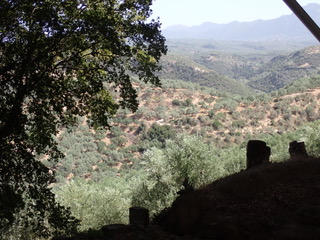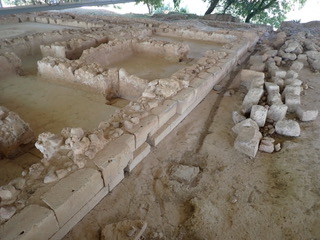37:39.151N 21:19.447E

Muskrat
Chris and Alison
Fri 14 Jun 2024 18:52
06/06/24 - 08/06/24 We left Methoni at 0955 and put the sails up in the hope of doing some sailing. The wind filled in from the NW and we had a sedate sail until 1230 when it died completely. We motored into Navarionu Bay, Pylos, and dropped the anchor in the west side of the bay. All sand and no rocks so the anchor dug in first time. Pylos Pylos was largely built by the French in the 19th century after the Battle of Navarinon and is typically French in style. The shaded square has a memorial to the three admirals who commanded the fleet which destroyed Turkish sea power, Admirals Codrington, de Rigny and von Heydon. Myth This is a city of significance in mythical terms and first crops up with the tale of Herakles. Herakles was the son of Zeus and a mortal woman, Alkmene. When Alkmene caught Zeus’ eye, she was freshly married and awaiting the return of her husband, Amphitryon, who was at the time away conspiring to chop off the golden hair of Taphus. Having done this, Amphitryon was keen to get back to consummate his marriage. However, Zeus had other ideas and, after news reached Alkmene that her husband was returning triumphant, Zeus took action, using his powers to transform himself into Amphitryon and hopping into bed with Alkmene. The next morning he scarpered back to Olympus, leaving Alkmene dazed, confused and pregnant. Alkmene was even more confused when the real Amphitryon turned up looking very chipper only to discover his wife had been ravished by a stranger. Fortunately for Alkmene, it soon came to light that the stranger was Zeus and all was forgiven. The result of this union was Herakles. As Zeus was his father, Herakles ended up being superhuman. He married Megaera and had children, unfortunately he went temporarily mad and killed the whole family. Herakles therefore went off to think about what he had done and consult an oracle, who said that the only way he could atone for this was to perform 12 seemingly impossible tasks. If he did that, all would be forgiven and he would gain immortality. He competed his 12 tasks but he is not popular in Pylos due to another incident that occurred after he had completed his 12 labours. Instead of chilling out, he murdered again, this time in Pylos, so once again he needed purification. He went and asked King Nereus of Pylos to absolve him, but Nereus simply told him to leave. Herakles stormed out of Pylos plotting revenge. A few years later, he returned to Pylos with a gang of ruffians and killed Nereus and 11 of his 12 sons. The surviving son, Nestor, only escaped because he happened to be away from the island at the time. Nestor then became King of Plylos and no one plays a more consistent role in Greek mythology than Nestor. He joined Jason and the Argonauts and also took part in two of the other great epic tales from Greek mythology, the hunting of the Caledonian boar, the war against the centaurs and he also took part in the Trojan war. So Nestor is inextricably tied to Pylos Jefferson S (2022) In the Wake of the Gods. A Cruising companion to The World of The Greek Myths So we just had to visit Nestors Palace (8 miles East inland). The remains are viewed as the best preserved Mycenaean Greek palace around and the site has been carefully excavated to display a fascinating selection of artefacts, including a bath carved out of stone that is reputed to be Nestors bath. We left Pylos at 0628 and started to motor towards Katakolon hoping against hope that we were not going to motor all the 50nm. Eventually at 1030 the wind started to fill in and we managed to start sailing. Apart for one hour when the wind died completely, we managed to sail for half the passage beating into a moderate swell until that calmed down towards the end of the passage. We anchored in sand and mud in Katakolon just off the harbour breakwater. Katakolon was built in 1875 for the then thriving currant trade. Now it is used principally by cruise ships as base for the visit to Olympia about 25 miles away (note to self, Cruise ship = a lot of people). It was Sunday the day after we arrived, so the train that would take us to Olympia did not run on Sundays, so we opted to look around the small town and visit the museum of Ancient Greek Technology. It was only a small museum on two floors and we only expected to be about half an hour for the entire visit. Over an hour later we could have still been studying the exhibits and learning about ancient Greek technology. It was a fascinating museum made more so by the enthusiasm of the young lady who showed us some of the exhibits and the fact we were the only visitors in the museum. We were going to visit Olympia the next day, Monday, however on Monday morning we were woken at 0600 by the sound of a large ship going alongside the dock. Up to 4000 passengers were on the cruise liner MSC and most of them clambering for a visit to Olympia. Chris got onto the internet and found a site that had a time table of all the cruise ships that were visiting Katakolon this year. Tuesday was the only day that there would be no ships, Wednesday there would be three ships docking in Katakolon. We decided to leave our visit to Olympia until Tuesday and let the cruise passengers have Olympia to themselves, all 4000 of them. Monday morning we got the train at 0840 and arrived in Olympic at 0930. The site was quiet except for a few coach loads, but it could have been a lot worse with all the cruise ship passengers. Olympia site is a rambling muddle of a place with a jumble of ruins overgrown by olive and maquis. The site itself, situated in a wooded valley with the twin rivers of Alfios and Kladhios running through it, is magical. It is difficult to imagine that this site hosted the ancient Panhellenic games for over a thousand years and that many of the Greek heroes we read about proved their worth on the track and field here. One of the wonderful things about these ancient games was that a sacred truce, the Ekeheiria was observed for the duration of the games and warring states would put aside their differences to partake in the events, presumably resuming hostilities after the games. At the first games the prize for winning was purely symbolic, a palm leaf and an olive branch, but later some professionalism crept in and winners could expect monetary rewards as well as kudos from their home state. Under the Romans large monetary prizes were awarded at the games at Olympia. The modern Olympic Games were revived by Baron Pierre de Coubertin in 1896. When he died his heart was brought here to be buried at Olympia. There is an excellent archeological museum at the site. View from Nestors Palace  Nestors Bath Tub  Nestors Palace  Ancient Olympic  Ancient Olympic  Sent from my iPhone |